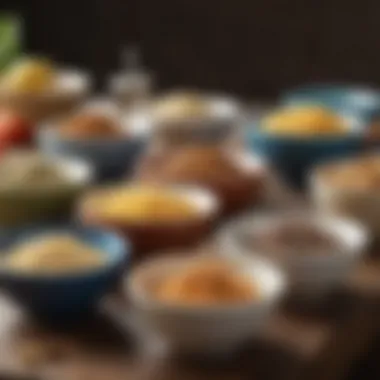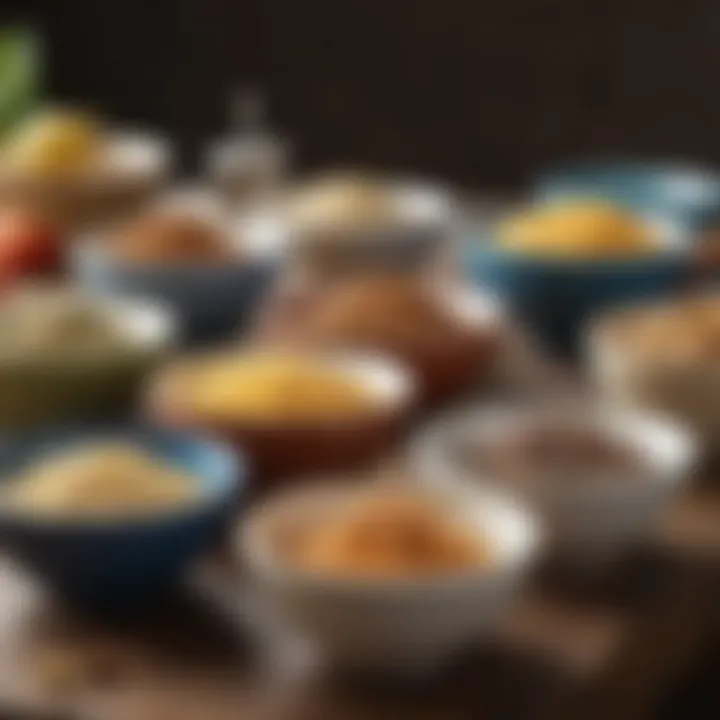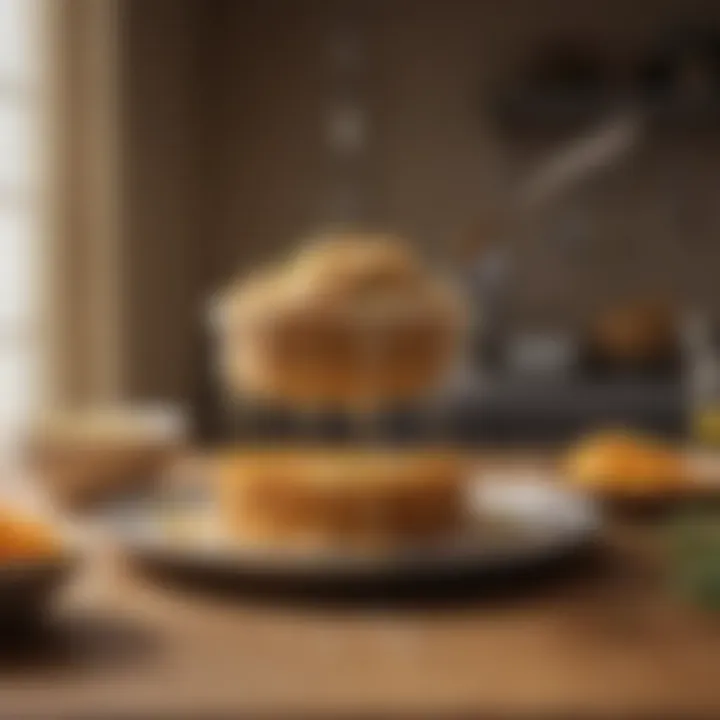Culinary Versatility: The Essence of 'Batter Up'


Intro
In the culinary realm, the phrase "batter up" rings with duality and creativity. Not only does it apply to the realm of sport, signaling a player ready to step to the plate, but it also emphasizes the savory world of cooking where batters come to play. This exploration dives deep into the various dimensions of batters, those delightful mixtures that can swing sweet or savory, easily adaptable across numerous recipes and cultural contexts. Understanding how to wield batter wisely is not just about following a recipe; it’s about embracing the art of cooking itself.
Culinary practices rooted in the use of batter span the globe, capturing traditions and innovations alike. From fluffy pancakes to rich tempuras, batters serve as the foundation that can elevate a dish from the ordinary to the extraordinary. Whether you're whipping up a classic cake, deep-frying vegetables, or exploring regional delicacies, the versatility of batter is boundless. Let’s embark on this flavorful journey, honing in on techniques, ingredient choices, and inventive recipes that will inspire home cooks and gourmet chefs alike. By mastering the nuances of various batters, readers can enhance their culinary repertoire - often discovering new cultural significance along the way.
As we navigate through this article, expect to find insights into creating the perfect batter, tips for choosing the right ingredients, and diverse recipes that span cuisines. Get ready to roll up your sleeves, and let’s get cooking!
Understanding the Essence of Batter
In the kitchen, the term "batter" goes far beyond just a mixture of flour and water. It's a vital foundation in diverse culinary practices, providing the textural and flavor base for an array of dishes. Understanding the essence of batter means grasping its pivotal role in both sweet and savory applications, enhancing flavors while serving as a canvas for creativity.
Batter’s versatility allows home cooks and professional chefs alike to innovate while maintaining culinary traditions. Indeed, every time one reaches for a whisk or spatula, they participate in a long lineage of cooking techniques that have evolved over centuries. Different forms of batter connect a global food culture, influencing what is enjoyed at dinner tables across the world.
Defining Batter in Culinary Terms
Batter can be defined as a semi-liquid mixture combining ingredients like flour, eggs, and liquid—usually water or milk. This combination varies in thickness, from light blends suitable for pancakes to thicker varieties for breads and cakes. The specific ratios of ingredients can drastically affect the final product, and understanding these distinctions is crucial.
Furthermore, batters can be classified broadly into two types: pour batters and drop batters. Pour batters are thin and can easily glide from a measuring cup (think pancake or crepe batter), while drop batters are thicker and require a spoon to transfer (like cookie dough). These definitions underline how science, art, and technique are intricately woven into the fabric of cooking.
The Role of Batter in Cooking
The role of batter is indeed multifaceted. Firstly, it acts as a binding agent, holding ingredients together to create a cohesive dish. For instance, when making a cake, the batter ensures that the flour, sugars, fats, and leavening agents come together seamlessly to form a structure that supports the final product.
Moreover, batter is essential for textures—think about the crunch of a well-fried piece of fish or the fluffy interior of a soufflé. These are outcomes resulting from various cooking processes of batter, whether it be baking, frying, or even poaching. It’s key in developing flavors as it absorbs and enhances food being cooked, adding layers of taste and mouthfeel.
To put it another way, batter is often reflective of cultural practices. In countries like Japan, the famous okonomiyaki uses a savory batter that highlights local ingredients and flavors. In Mexico, the light masa batter is foundational for tortillas and tamales. Thus, understanding batter goes beyond culinary technique; it connects to a much richer narrative of the world's diverse food traditions.
"The beauty of batter lies in its ability to transcend borders, encapsulating the essence of local cuisine while inviting iterations and innovations from afar."
Types of Batter: A Culinary Spectrum
Understanding the different types of batter is crucial in mastering culinary arts. Each type brings its unique texture, flavor, and purpose—knowing when to use liquid compared to thick batters can transform a standard dish into something memorable. The versatility of batter is not just about its ingredients; it's the backbone of many delightful creations found in kitchens worldwide.
Liquid and Thick Batters
Liquid batters are often fluid enough to pour easily. Think of pancakes or crepes; they spread out on a griddle, yielding light and fluffy results. The usual culprits that make up a liquid batter include flour, eggs, and milk, sometimes flavored with vanila or spices. Their major benefit lies in their ability to cook quickly, providing an instant meal or treat.
In contrast, thick batters have a high viscosity, yielding different results in baking and frying. A common example here would be the batter for cookies or certain cake mixes. They remain in place when scooped or spread, resulting in denser textures. This type of batter is excellent for foods like muffins that need to hold shape during the baking process.
Both liquid and thick batters serve distinct purposes in culinary practices. Recognizing when to use each type ensures achieving the desired outcome in both taste and appearance.
Sweet vs. Savory Batter
Batter isn't just about texture; it can also be classified by taste. Sweet batters are often enriched with sugars, resulting in delightful treats to suit dessert lovers. Think of the light, airy batter used for sponge cakes or the rich, sticky mix for brownies. These batters often utilize flavorings like cocoa or fruits, adding depth to the dish.
Savory batters, on the other hand, embrace herbs and spices, creating bold flavors that can enhance dishes like fish and chips. Using chickpea flour in some savory batters speaks to global culinary traditions while producing a crispy yet tender exterior when fried.
Inculcating sweet and savory components can lead to innovative recipes. For example, including cheese in a pancake batter provides a delightful twist, marrying both worlds on one plate.
Regional Variations of Batter
The world of batter is astounding in its variety, influenced by cultural ingredients, traditions, and tastes. Asian cuisines often use rice flour to create batters for various dumplings, producing textures that differ from their Western counterparts, which often rely on wheat. These unique ingredients transform the batter's outcome, proving that even a small change can yield surprising results.
Similarly, in Europe, regions like Italy embrace chickpea flour for their famed socca, a simple yet superbly tasty dish showcasing the essence of their local ingredients. Each region brings its flair, hence why
"the bare essentials of batter can tell a tale of its culture."
Furthermore, some batters serve specific purposes in traditional ceremonies or festivals, like batters for traditional pastries served during local holidays. Exploring these variations can offer unique recipe ideas and insights into the culinary landscape of different cultures.
In summary, knowing the types of batter expands creativity in the kitchen. Whether navigating the nuances of liquid and thick batters or blending sweet with savory, understanding regional variations adds layers to the culinary experience. This knowledge equips any home cook with the foundation necessary to make informed choices in their cooking endeavors.
Key Ingredients in Batter Preparation
Batter, often considered the unsung hero of culinary creations, owes much of its success to the ingredients that comprise it. Understanding the intricate roles of these components leads to superior outcomes in not just baking but a variety of cooking styles. The careful selection of ingredients in batter preparation can elevate a dish from mediocre to magnificent. Here’s a closer examination of the essential elements that make batters sing.
Flours: The Foundation of Batter


Flour serves as the backbone of any batter. Its type and quality directly influence the texture and flavor. All-purpose flour, often the go-to choice, strikes a balance between strength and versatility, making it suitable for numerous applications. However, specialty flours such as cake flour or whole wheat flour can cater to specific textures and tastes.
"The choice of flour can be the difference between a light soufflé and a dense pancake."
The gluten content in flour affects the batter's ability to rise, which is crucial for baked goods. Higher gluten flours like bread flour create a chewier texture, while lower-gluten alternatives like cake flour yield a soft, tender crumb. Understanding how various flours react during cooking can help cooks experiment with and perfect their recipes.
Liquids: Choosing the Right Consistency
Liquids play a pivotal role in determining the final structure of the batter. Water, milk, buttermilk, and even fruit juices not only hydrate the flour but also contribute to the flavor and texture. The liquid-to-dry ingredient ratio is crucial; too much liquid results in a loose, runny batter, while too little makes it thick and hard to work with.
For example, using buttermilk can add a delightful tang, achieving a moisture-rich batter that rises beautifully, perfect for pancakes or cakes. On the contrary, water creates a neutral base, often necessary for savory batters like tempura. Knowing when and how to adjust liquid can make a world of difference.
Leavening Agents: The Rise of Batter
Leavening agents are responsible for creating the airy textures we often associate with baked goods. Whether using baking powder, baking soda, or yeast, each agent produces its unique effect. Baking powder is a favorite for batters requiring an immediate lift; it reacts upon mixing and again when heat is applied. In contrast, yeast contributes a slow fermentation, creating deep flavors and a chewy texture prevalent in artisanal breads.
The quantity of leaveners can drastically shift the outcome. Too much can lead to a collapsed batter, while too little may yield a dense final product. This delicate balance between the amount of leavening agent and other ingredients is crucial in perfecting batter recipes.
Techniques for Crafting Perfect Batter
When it comes to the culinary world, crafting the perfect batter may well be regarded as a fine art. This section dives into the nuances of techniques that elevate batter preparation from a simple task to a true culinary endeavor. Understanding these methods not only enhances the final product but can also bring a level of assurance to a cook, whether they are a novice or experienced chef. From mastering mixing techniques to grasping the significance of resting times and temperature control, each element is a piece of a greater puzzle in the pursuit of batter excellence.
Mixing Methods: Gentle or Vigorous?
The first step in preparing batter is often overlooked - the mixing method. The choice between gentle or vigorous mixing can have a dramatic impact on the texture and outcome of the dish.
- Gentle Mixing: Best utilized for batters that incorporate air, such as sponge cakes or delicate pancakes. A light touch encourages the formation of air pockets, promoting a lighter end product. This method involves folding ingredients rather than stirring aggressively.
- Vigorous Mixing: Often employed for thicker batters, like those for brownies or certain quick breads. A robust blend combines ingredients effectively and distributes leavening agents evenly. However, overmixing can lead to gluten development, resulting in a denser texture.
It’s always a dance between achieving the right consistency and not overworking the batter. Striking a balance is the name of the game.
Resting Time: Importance and Benefits
The importance of resting batter can sometimes be underappreciated, but it can be the secret weapon in a cook's arsenal. Allowing the batter to rest before cooking or baking can lead to significant improvements in flavor and texture.
- Flavor Development: Resting enables the flour to fully hydrate, allowing starches to break down and sugars to meld. This can enhance the overall flavor profile considerably.
- Texture Improvements: With time, gluten relaxes, which can result in a more tender product. This is particularly beneficial for batters used in waffles or crepes.
“Resting your batter is like letting a fine wine breathe — a little patience goes a long way.”
Temperature Effects on Batter Consistency
Finally, one cannot overlook the impact temperature has on batter. The science behind how temperature affects the consistency is pivotal in achieving the desired results.
- Cold Ingredients: Using cold eggs or milk can inhibit proper emulsification and may result in a thicker batter. This may, however, be desirable in certain contexts, such as when making a thicker bread batter.
- Room Temperature Ingredients: Having ingredients at room temperature can often lead to a more unified mixture, promoting better aeration and ultimately a lighter finished product. Many cake batters benefit from this approach.
- Environmental Temperature: The kitchen itself can influence batter outcomes. On a hot summer day, a batter may behave differently than on a winter's night. Adjusting the technique slightly based on the environment can help.
Understanding these techniques is vital for anyone looking to refine their batter creations. With every fold, rest, and adjustment, we inch closer to that perfect batter that delights and satisfies.
Culinary Applications of Batter
In the culinary arts, understanding how to utilize batter effectively can be the cornerstone of many delightful dishes. From textures to flavors, the applications of batter stretch far and wide, making it a vital area of focus for any cooking enthusiast or professional chef. The versatility of batter is astounding; it can be the base for sweet cakes, the coating for crispy fried treats, or even a foundation for savory delicacies. By mastering the various applications where batter shines, one can elevate their cooking skills to new heights, making meals not only delicious but memorable.
Batter in Baking: Cakes and Muffins
Baking with batter often conjures images of fluffy cakes and soft muffins. The essence of a cake lies within its batter, where the interaction between flour, sugar, eggs, and fats creates a delightful structure. As these ingredients mingle, they form a batter that rises gently in the oven, producing a treat that is often light and airy.
It's essential to consider the balance of moisture and dryness. For instance, a heavy batter can lead to dense cakes, while a well-mixed batter with the right ratio of ingredients results in a spongy delight. Common ones like vanilla cake, chocolate muffins, or even lemon drizzle cake all demonstrate how nuanced the process can be. Remember, even minor adjustments in ingredients can lead to significant changes in the final product.
- Key Points in Baking Batter:
- Texture and Structure: Importance of flour type
- Flavor Integration: Using spices and extracts
- Experimentation: Trying different fats and sweeteners
"The beauty of batter lies in its potential. Small changes can lead to beautifully diverse outcomes."
Frying with Batter: Techniques and Secrets
Frying with batter opens up a world of crispy textures and rich flavors. Whether it’s the crunch of batter-fried fish or the golden hue of tempura vegetables, the right frying technique can elevate simple ingredients into extraordinary dishes. When preparing batter for frying, there are a few techniques that set a seasoned cook apart from a novice.
Consider the temperature of your oil. Too hot, and the batter might burn before cooking through; too cool, and it can absorb excess oil, leading to greasy results. Many chefs prefer using a light batter, often made with chilled water or even sparkling water, which creates an airy crunch.
- Secrets for Successful Frying:


- Temperature Checks: Using a thermometer
- Batter Thickness: Finding the perfect coating level
- Patience: Avoid overcrowding the pan
Savory Dishes: Beyond Desserts
While desserts get most of the limelight, the applications of batter extend far into savory dishes, with culinary traditions employing batter in ways that surprise and delight. Think of the crispy coatings of savory fritters, the rich flavors of a batter-infused quiche, or crispy onion rings that are a staple at many fairs and picnics. Each savory dish tells its own story, and the batter often serves as an unifying element that brings the flavors together.
For instance, Asian cuisines use different batters for tempura or bhaji, where the emphasis is on balancing the taste and crunch. Even in the Western world, dishes like stuffed crepes or savory pancakes showcase the diversity that batter can offer beyond the realm of sweets.
- Savory Batter Applications:
- Fritters: Using various vegetables and proteins
- Pancakes: Savory variations with herbs and cheese
- Battered Fish: The classic fish and chips
Through this exploration of the culinary applications of batter, the art of cooking unveils countless opportunities for creativity and innovation. The world is rich with diverse recipes that await transformation to suit personal taste and regional flavors.
Cultural Aspects of Batter-Based Dishes
Exploring the cultural aspects of batter holds great significance in this article as it reveals the rich history and diversity of culinary practices across the globe. Batter not only serves as a foundational element in many dishes but also reflects regional ingredients, traditions, and social interactions surrounding food. By understanding these aspects, we can appreciate the role of batter in connecting people, fostering community, and celebrating culinary artistry.
Batter Traditions Around the World
Batter traditions vary widely from one region to another, showcasing how local customs and available resources shape food practices. For instance, in Italy, the beloved pizza starts with a yeast-leavened batter, creating a thin crust that’s the base for a variety of toppings, while tempura from Japan exemplifies how a simple flour and water batter can encapsulate seasonal vegetables or seafood, transforming them into a crisp delight.
In India, bhaji—a chickpea flour-based batter used for frying vegetables—extends beyond just a snack and is steeped in local festivals and social gatherings. Similarly, in Nigeria, akara, made from black-eyed peas, reflects communal cooking, often served during breakfast or special occasions.
These examples show us that batter-based dishes are not merely culinary creations; they are woven into the fabric of cultural identities. Foods that utilize batter often carry stories of community gatherings, family recipes, or historical significance, thus enhancing the cooking experience.
Food Rituals and Celebrations Involving Batter
Batter plays a central role not just in everyday meals, but also in rituals and celebrations across cultures. For instance, pancakes made from batter appear in various forms and meanings in different cultures; they symbolize prosperity in some countries during New Year celebrations. In France, crêpes are often made during Candlemas, a festival celebrating the presentation of Jesus at the temple.
In Mexico, the tradition of making buñuelos—sweet fritters—during Christmas evokes nostalgia and togetherness. These batter-based treats are family favorites, bringing together loved ones for a festive celebration.
Batter-based dishes are surely present in many celebrations, yet they can also serve as a medium for expression of cultural values. The act of preparing and sharing these dishes fosters bonds and creates lasting memories. Additionally, -- even when derived from different places -- the global fascination with batter has sparked interesting culinary exchanges and adaptations that continue to evolve with the times.
"Food traditions tell us who we are, and batter, at its core, connects our personal histories with our shared experiences."
Health Considerations in Batter Preparation
In the realm of cooking, health considerations hold a critical spot, especially when it comes to preparing batters. Whether for a cake, pancake, or a savory fritter, understanding what's in your batter goes a long way. Batters are often a mix of simple yet versatile ingredients, and by considering health aspects, we can make better choices that align with our dietary needs and preferences. This section will unpack the nutritional profiles, allergen considerations, and healthier alternatives that can transform how we enjoy this culinary staple.
Nutritional Profiles of Common Batters
Batters vary widely based on their primary ingredients, influencing their nutritional value. A basic pancake batter, for instance, usually comprises flour, milk, eggs, and a leavening agent. Each component contributes to the batter's overall nutrient profile:
- Flour: The foundation ingredient. White all-purpose flour is common, but it lacks fiber. Whole wheat flour, on the other hand, boosts fiber and nutrients, offering a fuller profile.
- Milk: Adds protein and calcium. Non-dairy alternatives like almond or oat milk may provide fewer calories but might lack the same protein content.
- Eggs: Packed with protein and vitamins, they bind the ingredients, but they may be a concern for those managing cholesterol.
- Leavening Agents: Baking powder and baking soda vary in chemical complexity and calorie contribution.
By swapping one ingredient for another, such as using oat flour instead of regular flour, you can elevate the nutrients while still enjoying a delicious dish.
"A little change in your batter could lead to a healthier bite!"
Allergen Considerations in Batter Ingredients
Allergies can pose a significant challenge when preparing traditional batters. Multiple elements can trigger reactions, often depending on personal sensitivities. Common allergens found in batters include:
- Wheat: The most prevalent allergen in batters like pancakes and cakes. A wheat allergy may force individuals to look for gluten-free alternatives.
- Dairy: Milk and butter are often key components. Lactose intolerance or dairy allergies may lead to the need for non-dairy substitutions.
- Eggs: Found in many batters, eggs can be a crucial ingredient for rising and binding. For those with allergies, egg replacements such as flaxseed or applesauce can be effective solutions.
Being aware of potential allergens enables one to tailor batters to meet dietary restrictions while ensuring everyone can partake in a meal.
Healthy Alternatives to Traditional Batters
In today's health-conscious culinary landscape, many are seeking ways to enjoy their favorite batter-based dishes without sacrificing nutrition. This is where innovative alternatives come into play:
- Almond Flour or Coconut Flour: These gluten-free flours provide healthier options with added fiber and lower carbs.
- Chia Seeds or Flaxseeds: As mentioned before, these can serve as egg replacements. They also add omega-3 fatty acids, promoting heart health.
- Greek Yogurt: Replace part of the liquid with Greek yogurt for added protein and creaminess without excess fat.
- Applesauce or Mashed Bananas: Perfect for adding moisture and natural sweetness, cutting down on sugar and fat content found in traditional batters.
By considering these alternatives, not only can batters become healthier, but they can evolve into nourishing comfort foods that align with contemporary dietary trends.
Through mindful selection of ingredients and techniques, health considerations in batter preparation can lead to dishes that are not just enjoyable but also bolster well-being.


Innovations and Trends in Batter Recipes
The evolution of batter recipes reflects broader culinary trends, constantly adapting to changing tastes and lifestyles. Innovations in batters not only enhance flavor but also cater to evolving dietary needs. As the culinary world becomes more intersectional, this section highlights the significance of these innovations, examining how they influence various aspects of cooking and food culture today.
Modern Twists on Classic Batters
Today's chefs and home cooks alike are taking traditional batter recipes and giving them modern spins. This could mean swapping everyday ingredients for more interesting alternatives. For example, classic pancake batters now might feature oat flour instead of all-purpose flour, leading to a heartier and gluten-free option.
Moreover, flavored batters are all the rage. Think chai-spiced cake batter or matcha-infused muffins. These tweaks not only please the palate but also inject variety into meals, making every bite a bit of an culinary adventure. Surprise factors are often at play; adding savory herbs to sweet batters can create unique flavors that elevate standard recipes.
Other notable innovations include:
- Infusion of Superfoods: Incorporating chia seeds or spirulina to amplify nutritional value.
- Texture plays: Using techniques like blending or whipping egg whites separately to achieve fluffiness.
- Fermentation: Introducing sourdough elements as a way to infuse unique flavors into batters while improving digestibility.
The trend of mindfully exploring ingredients is also steering many towards seasonal or local produce, fostering a greater connection to food sources.
Sustainable Ingredients for Batter
As sustainability becomes a top concern around the globe, many culinary enthusiasts are reevaluating what goes into their batters. This isn't just about health—it's also about making choices that respect the planet.
Opting for sustainable ingredients can manifest in several ways:
- Organic flours: Sourcing from local mills that prioritize sustainable farming.
- Plant-based options: Using alternatives to dairy, such as almond milk or oat milk, not only makes batters more inclusive for various diets but also lessens the carbon footprint.
- Less sugar: Exploring natural sweeteners like maple syrup or honey, which can encourage less processed options.
Furthermore, there's a growing movement towards utilizing ingredients that reduce food waste. This includes repurposing overripe fruits in sweet batters or integrating vegetable purees into savory mixes to create delicious, innovative dishes. Such shifts not only nurture one's health but ensure the culinary arts evolve in a manner attuned to environmental considerations.
"The future of batter recipes not only tantalizes the taste buds but also nurtures our planet. Every little choice counts."
These trends reflect a broader understanding of food as a vehicle for change. By incorporating sustainable practices and modern approaches, batter recipes are not just enhancing meals but also contributing to a healthier planet.
Batter in the Digital Age: Influences and Accessibility
In our modern era, the culinary landscape is rapidly evolving, largely driven by technology and its ubiquitous presence in our lives. The phrase "batter up" takes on new meaning in this context, as we explore how digital tools and social platforms shape the way we prepare and appreciate batter in the kitchen. This section highlights crucial aspects of how technology fosters an accessible culinary experience, allowing enthusiasts—from novice cooks to seasoned chefs—to experiment with batter recipes and techniques like never before.
Impact of Social Media on Batter Trends
Social media has emerged as a culinary powerhouse, transforming how trends take shape and flourish. Platforms like Instagram and TikTok have become arenas where both amateurs and professionals showcase their skills, leading to the rapid spread of batter-related innovations. The importance of visuals cannot be overstated; striking images and short videos capture attention, enticing viewers to engage with various batter recipes.
Take, for instance, the viral success of fluffy pancake recipes or decadent cake batters. Just one eye-catching post can ignite a wave of imitation, with users enthusiastically recreating their favorite dishes at home. The hashtags attached to these posts serve as invaluable tools, allowing others to discover new techniques or variations of classic batters.
These platforms serve not only as a venue for sharing recipes but also as a community space where cooks can exchange tips and experiences, often encouraging experimentation beyond traditional boundaries.
"Social media is the new culinary playground; it reshapes how we think about food, inviting creativity like never before."
Online Resources for Batter Recipes and Techniques
The internet is a treasure trove of resources dedicated to batter preparation. Websites, blogs, and culinary forums provide endless inspiration, showcasing a multitude of recipes that cater to varied tastes and dietary preferences. Notably, forums on platforms like Reddit allow users to share personal tips or modifications based on their unique culinary experiences. This collaborative spirit fosters an environment where innovation thrives.
Here are some useful resources:
- Recipe websites: Sites like AllRecipes and BBC Good Food feature extensive batter recipes, adding depth to traditional dishes while also incorporating modern twists.
- Cooking blogs: Many enthusiasts document their culinary journeys, often focusing on specific batters, whether they hail from regional traditions or global influences.
- Videos and tutorials: These provide step-by-step guidance, which can be invaluable for those who prefer a visual learning experience.
- Social media groups: Platforms like Facebook host groups where members share recipes, experiences, and even troubleshooting advice, enhancing the learning experience for all involved.
The Future of Batter in Culinary Arts
The realm of culinary arts is forever evolving, influenced by trends, technologies, and consumer demands. The future of batter, a staple in both sweet and savory dishes, is no exception. One could argue that the possibilities are endless, and as we look ahead, it's clear that several factors will shape the way batter is perceived and crafted in kitchens around the globe.
Emerging Ingredients and Techniques
In an age where food innovation is at its peak, the evolution of batter includes a diverse array of ingredients and techniques. Gone are the days where simple flour-and-water mixtures dominated the landscape. Today, chefs are experimenting with alternative flours like almond, coconut, and chickpea, which cater to gluten-free diets and those looking for healthier options. These flours not only add unique flavors but also enhance nutritional value, creating batters that are as wholesome as they are delicious.
Techniques have also seen a shift. Traditional methods of batter preparation are being reimagined. Sous-vide, for example, is making waves in batters, allowing a whole new layer of flavor and texture. This technique ensures even cooking while infusing batters with aromatic herbs and spices in a way that's both time-efficient and flavorful.
Every batter tells a story, and with the rise of fusion cuisine, the ingredients used are often the result of cultural exchanges, becoming vessels for creativity.
Another exciting frontier is the utilization of biotechnology in ingredient development. Some businesses are working on plant-based alternatives that simulate textures and flavors of traditional ingredients, paving the way for innovative batters that align with sustainable practices. Imagine a coconut-based batter that not only tastes good but also reduces environmental impact. It’s not just about what goes into a batter anymore; it’s about how it effects the world.
Culinary Education and Batter Proficiency
As the culinary landscape transforms, so too does the education surrounding it. Culinary schools and workshops are increasingly focusing on teaching future chefs about batter proficiency. No longer is it enough to know a handful of traditional recipes; emerging chefs must be equipped to innovate, experiment, and adapt.
Programs are now emphasizing a solid understanding of food science, enabling young cooks to grasp how various ingredients interact within a batter. For instance, knowing the right ratios of leavening agents can turn a simple batter into a fluffy masterpiece.
Moreover, online platforms have democratized access to knowledge. Aspiring cooks from anywhere can find tutorials and masterclasses on creating diverse batters, understanding their compositions and learning about techniques that were once only passed down through generations of chefs. This shift enriches the culinary community, fostering a spirit of creativity and collaboration.
In closing, the future of batter in the culinary arts doesn't just focus on what we can make but also how we make it. By embracing emerging ingredients, innovative techniques, and a robust educational framework, the possibilities for batters may just be the cherry on the cake—or the drizzle on the batter-dipped donut!







